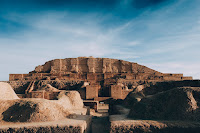Land of Shinar
The arrogant acts of Nebuchadnezzar in the Book of Daniel parallel the incident at the Tower of Babel in Genesis. The Book of Daniel begins by referring to the Babylon of Daniel’s day as the “Land of Shinar,” a verbal link to the story of the Tower of Babel in Genesis and the founding of the city of Babel that centuries later became the capital of the Neo-Babylonian Empire. That incident is echoed again in the third chapter of the Book when Nebuchadnezzar gathered all the nations and peoples of his realm to pay homage to the great golden image that he had “set up” on the Mesopotamian plain.
 |
| [Ziggarut - Photo by Sam Moghadam Khamseh on Unsplash] |
Biblically speaking, Nebuchadnezzar’s empire was not a new political entity. It had an ancient pedigree. It was the descendant of the old Mesopotamian civilization. The imperial city in which Daniel found himself was the latest incarnation of the World Empire that has existed since the beginning of human civilization, at least as recorded in the Book of Genesis.
God thwarted the completion of the high tower in the “Land of Shinar,” resulting in the distribution of languages, nations, and cultures across the Earth. That story provides the reader with the true origins of the World Empire.
- (Daniel 1:1-2) – “In the third year of the reign of Jehoiakim king of Judah, came Nebuchadnezzar king of Babylon to Jerusalem, and laid siege against it; and the Lord gave into his hand Jehoiakim king of Judah and a part of the vessels of the house of God, and he brought them into the land of Shinar into the house of his gods, and the vessels brought he into the treasure-house of his gods.”
Daniel’s opening paragraph builds on the story from Genesis when the “whole Earth was of one language and one speech.” Noah’s descendants migrated to Mesopotamia to dwell “in the Land of Shinar.”
The name ‘Shinar’ is the Hebrew equivalent of ‘Sumer,’ the first known civilization in Mesopotamia.
The people of Shinar began to build a city with a high tower that would “reach the heavens and thus make us a name, lest we be scattered across the whole earth.” The description reflects the Sumerian culture in which cities featured temples built on ziggurats - tiered mounds that formed the highest point in a city. Dedicated to its chief deity, the civil, economic, and religious activities centered on a city’s temple.
Originally, Yahweh commanded Adam to “multiply, replenish and subdue the Earth,” a command reiterated to Noah after the Great Flood.
However, humanity chose instead to move to Mesopotamia and build a new civilization centered there, and to make a name for itself. Moreover, in the Hebrew Bible, Babylon is characterized by its presumption and arrogance - (Genesis 1:28, 9:1, Isaiah 14:13-14, 63:12-14, Jeremiah 32:20).
If humanity united under one language, the wickedness of humanity would know no bounds. By confounding their language, God caused the nations to spread throughout the Earth, and thereby, He stopped the first attempt to establish a centralized empire. In this way, the idolatrous ambitions of Babylon were delayed, at least, until a more opportune time.
The Bible calls that ancient city ‘Babel,’ the place where “Yahweh confounded the language of all the earth.” The name may be related to the Hebrew word balal or “confusion,” although in the Akkadian language of Mesopotamia bab-ili (‘Babel’) meant the “gate of god.”
Thus, the king of the “Babel” of Daniel’s day attempted to reverse God’s original judgment. Having conquered the Kingdom of Judah, Nebuchadnezzar set out to gather different ethnic groups, cultures, and nations to his rebuilt city where the people were educated in the “language of Babylon,” the latest incarnation of the World Empire.
The story of Nimrod is found in the so-called ‘Table of Nations’ in Genesis, the man the Bible links to the founding of Mesopotamian civilization, and the builder of several of its chief cities, including Babel, Asshur, and Nineveh.
Nimrod became “a mighty one in the earth,” a term that reflects the “mighty men of name,” the gibborim, warriors who established fearsome reputations through violent exploits - (Genesis 6:4-13, 10:8-12).
Likewise, Nimrod was a “mighty hunter before the face of Yahweh.” The description denotes his opposition to Yahweh, not God’s approval. His name, Nimrod, is derived from the Hebrew word mārăd - “We will revolt” – and elsewhere he is used to typify despotic rulers that oppressed Israel - (Micah 5:6).
PARALLELS IN DANIEL
In Genesis, the “whole earth spoke one language” as men began to dwell in “Shinar.” They built a city and tower of “great height” in the plain of Shinar to mark their achievements and prevent humanity’s dispersal.
Likewise, in Daniel, Nebuchadnezzar brought captives to Babylon, the great city that HE BUILT. Exiles from other nations were educated in the “LANGUAGE OF THE CHALDEANS.” Hence, what the original inhabitants of Babel began to do, Nebuchadnezzar attempted to complete.
Nebuchadnezzar “SET UP” a great golden image of exceptional “HEIGHT” in the “PLAIN of Dura,” then decreed that “ALL PEOPLES, RACES, AND TONGUES” must gather and render homage to it. He summoned representatives from every province and nation “to the dedication” of his great and “HIGH” image - (Daniel 3:1-8).
The verbal parallels are deliberate. Just as the earlier inhabitants of Mesopotamia united to build a city and high tower for their own glory, so the contemporary king of “Babel” presumed to unite all men under his authority and have them pay homage to the great image he “set up” to magnify his own glory and power.
RELATED POSTS:


Comments
Post a Comment
We encourage free discussions on the commenting system provided by the Google Blogger platform, with the stipulation that conversations remain civil. Comments voicing dissenting views are encouraged.